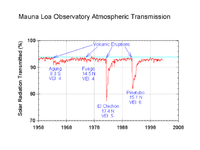
Photo from wikipedia
Feedbacks between climate warming, land surface aridity, and wildfire-derived aerosols represent a large source of uncertainty in future climate predictions. Here, long-term observations of aerosol optical depth, surface level aerosol… Click to show full abstract
Feedbacks between climate warming, land surface aridity, and wildfire-derived aerosols represent a large source of uncertainty in future climate predictions. Here, long-term observations of aerosol optical depth, surface level aerosol loading, fire-area burned, and hydrologic simulations are used to show that regional-scale increases in aridity and resulting wildfires have significantly increased summertime aerosol loading in remote high elevation regions of the Intermountain West of the United States. Surface summertime organic aerosol loading and total aerosol optical depth were both strongly correlated (p < 0.05) with aridity and fire area burned at high elevation sites across major western US mountain ranges. These results demonstrate that surface-level organic aerosol loading is dominated by summertime wildfires at many high elevation sites. This analysis provides new constraints for climate projections on the influence of drought and resulting wildfires on aerosol loading. These empirical observations will help better constrain projected increases in organic aerosol loading with increased fire activity under climate change.
Journal Title: Environmental Research Letters
Year Published: 2017
Link to full text (if available)
Share on Social Media: Sign Up to like & get
recommendations!